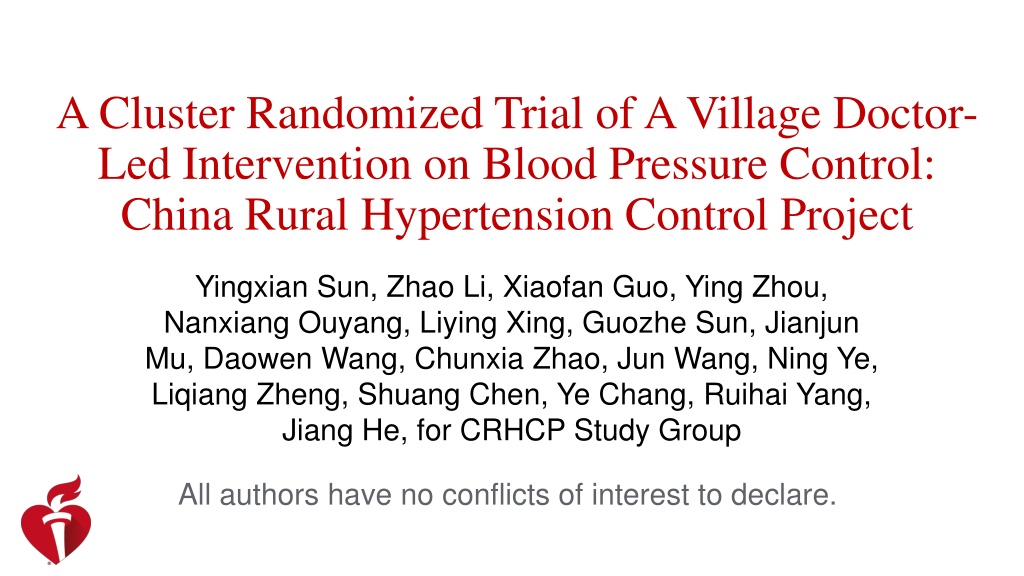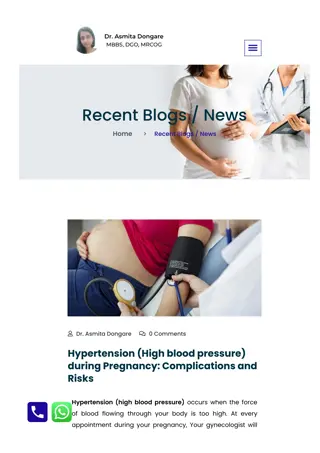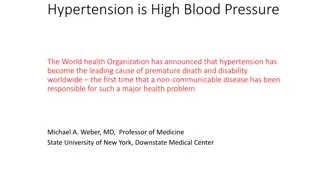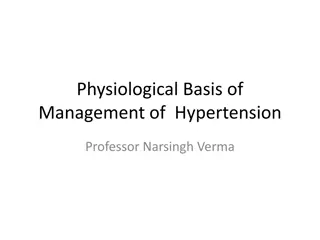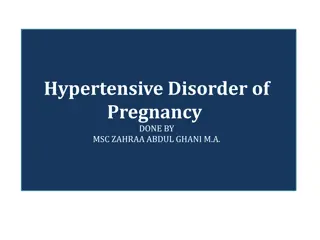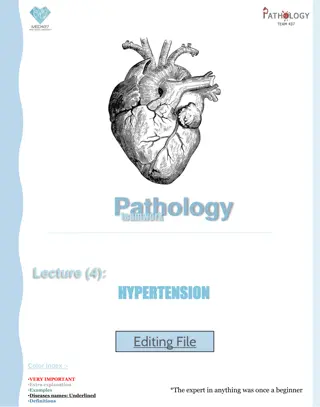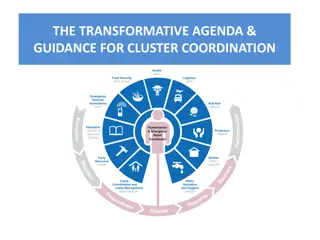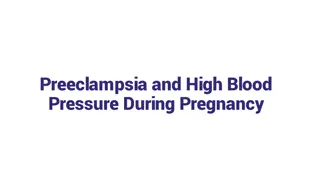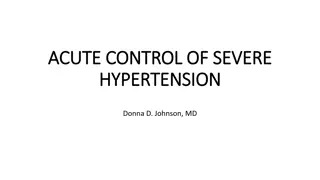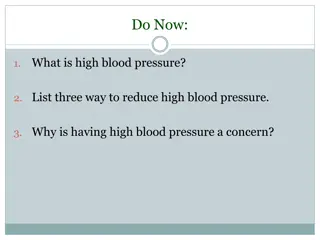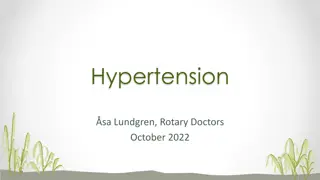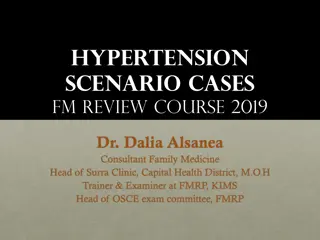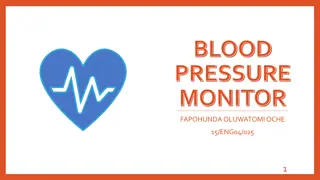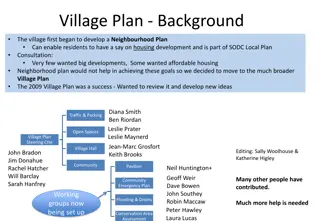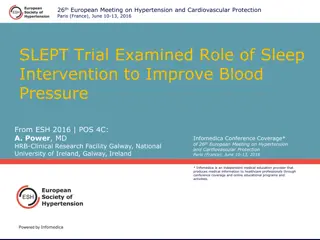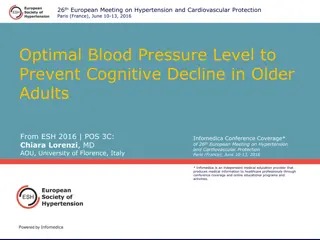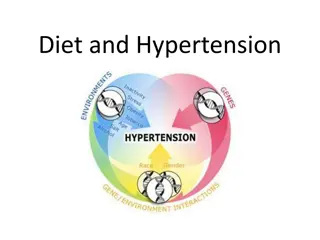A Cluster Randomized Trial of a Village Doctor-Led Intervention on Blood Pressure Control: China Rural Hypertension Control Project
This study aimed to assess the effectiveness of a village doctor-led intervention on blood pressure control in rural China. The multifaceted intervention, compared to usual care, targeted residents with hypertension over 18 months. The project also tested the feasibility of a stricter blood pressure treatment goal. Enrollment, randomization, and follow-up procedures as well as the study participants' criteria were outlined. The findings shed light on improving hypertension management in low- and middle-income countries.
Download Presentation

Please find below an Image/Link to download the presentation.
The content on the website is provided AS IS for your information and personal use only. It may not be sold, licensed, or shared on other websites without obtaining consent from the author. Download presentation by click this link. If you encounter any issues during the download, it is possible that the publisher has removed the file from their server.
E N D
Presentation Transcript
A Cluster Randomized Trial of A Village Doctor- Led Intervention on Blood Pressure Control: China Rural Hypertension Control Project Yingxian Sun, Zhao Li, Xiaofan Guo, Ying Zhou, Nanxiang Ouyang, Liying Xing, Guozhe Sun, Jianjun Mu, Daowen Wang, Chunxia Zhao, Jun Wang, Ning Ye, Liqiang Zheng, Shuang Chen, Ye Chang, Ruihai Yang, Jiang He, for CRHCP Study Group All authors have no conflicts of interest to declare.
Background Hypertension is the leading global preventable risk factor for CVD and premature death. Approximately 75% of individuals with hypertension live in low- and middle-income countries. The prevalence of hypertension is high and increasing in China. In the most recent national survey in 2014, 27.8% or 292 million Chinese adults had hypertension (BP 140/90 mm Hg). The proportion of patients with controlled BP in China is low. Only 5.5% of hypertensive patients had BP controlled (<140/90 mmHg) in rural China in 2014. Village doctors (formerly known as barefoot doctors) have traditionally provided basic primary healthcare in rural China. With appropriate training, they could play an important role in hypertension control in rural China.
Objectives To test the effectiveness of a village doctor-led multifaceted intervention compared to usual care on BP control over 18 months among rural residents with hypertension in China. To test the feasibility of implementing a more stringent BP treatment goal (<130/80 mmHg) than that in the China Hypertension Guidelines (<140/90 mmHg).
Enrollment, Randomization, and Follow-up 326 villages selected from 3 provinces in China 326 villages randomized 163 villages randomized to intervention 163 villages randomized to usual care 23780 patients assessed for eligibility 22960 patients assessed for eligibility 6373 excluded 6372 excluded 17407 patients enrolled to intervention 16588 patients enrolled to usual care 1953 patients lost to follow-up 2064 patients lost to follow-up 15454 patients completed 18-month follow-up 14524 patients completed 18-month follow-up 17407 patients included in data analysis 16588 patients included in data analysis
Study Participants Men and women aged 40 years with a mean untreated SBP 140 mmHg and/or DBP 90 mmHg or mean treated SBP 130 mmHg and/or DBP 80 mmHg from six measures on two different days were eligible for this trial. Patients with a history of CVD, diabetes, or CKD and mean SBP 130 mmHg and/or DBP 80 mmHg were also eligible. In addition, patients were required to be enrolled in the China New Rural Cooperative Medical Scheme, which covers 99% of rural residents for basic healthcare services.
Intervention A simple stepped-care protocol for hypertension treatment, adapted from the 2017 American College of Cardiology/American Heart Association hypertension clinical guideline, was implemented to achieve a target SBP <130 mmHg and DBP <80 mmHg.
Implementation Strategies Village doctors in the intervention group were trained on standardized BP measurement, protocol-based antihypertensive treatment, and health coaching. Village doctors initiated and titrated antihypertensive medications, conducted health coaching on lifestyle modification and medication adherence, and followed patients up monthly. Village doctors were supervised by primary-care physicians from township hospitals and hypertension specialists at city or county hospitals. Patients in the intervention villages received discounted or free antihypertensive medications, home BP monitors, and health coaching.
Statistical Analysis Intention-to-treat analyses was conducted. The difference in the proportions of patients with controlled blood pressure between the two comparison groups was tested using a generalized linear mixed-effects model. Cluster effects were accounted for by assuming a compound-symmetry covariance structure. The net differences in mean blood pressure changes between the intervention and control groups were tested using a linear mixed-effects model. Participants and villages were assumed to be random effects, and the intervention was assumed to be a fixed effect. We also conducted prespecified subgroup analyses by age, sex, education level, history of antihypertensive treatment, and baseline risk for cardiovascular disease.
Baseline Characteristics of Study Participants Intervention (n=17,407) Control (n=16,588) Characteristics Age (years), mean (SD) 62.8 (9.2) 63.2 (9.2) Women, No. (%) 10,603 (60.9) 10,222 (61.6) High-school education, No. (%) 5,872 (34.0) 5,254 (32.0) Use of antihypertensive medications, No. (%) 10,574 (60.7) 8,990 (54.2) Duration of hypertension (years), median (IQR) 7 (5-11) 7 (4-11) Body-mass index (kg/m2), mean (SD) 26.0 (3.9) 25.8 (3.8) Systolic blood pressure (mmHg), mean (SD) 157.0 (18.0) 155.5 (17.3) Diastolic blood pressure (mmHg), mean (SD) 88.1 (10.7) 87.3 (10.6) 10-year risk for atherosclerotic CVD (%), mean (SD) 14.6 (11.9) 14.4 (11.6)
Effectiveness of the Village Doctor-Led Intervention on the Primary and Secondary Outcomes Proportion or mean change (95% CI) Intervention Net difference (95% CI) P value Study outcomes Usual care Primary outcome Proportion of patients with BP <130/80 mmHg at 18 months, % Secondary and other outcomes Proportion of patients with BP <140/90 mmHg at 18 months Change in SBP from baseline to 18 months, mmHg 57.0 19.9 37.0 <0.001 (55.3, 58.7) (18.7, 21.2) (34.9, 39.1) 77.3 44.5 32.7 <0.001 (75.8, 78.8) -26.3 (-27.1, -25.4) (43.0, 46.1) -11.8 (-12.6, -11.0) (30.6, 34.9) -14.5 (-15.7, -13.3) <0.001 Change in DBP from baseline to 18 months, mm Hg -14.6 -7.5 -7.1 <0.001 (-15.1, -14.2) (-7.9, -7.2) (-7.7, -6.5)
Proportion of Patients with Controlled Blood Pressure During Trial Follow-up Blood Pressure < 130/80 mm Hg Blood Pressure < 140/90 mm Hg 80% 100% Intervention Control 77.3% 80% 60% 57.0% 51.8% 60% 45.4% 27.0% 40% 40% 44.5% 17.9% 36.4% 20% 19.9% 12.6% 20% 6.5% 21.4% 13.4% 13.3% 0.0% 0% 0% 0 6 12 18 0 6 12 18 Months Months
Mean Systolic and Diastolic Blood Pressure During Trial Follow-up Systolic Blood Pressure Diastolic Blood Pressure 180 100 157.0 90 160 87.9 154.8 84.5 155.4 146.5 82.7 87.2 143.5 80 140 79.5 81.0 142.9 141.5 78.2 130.5 73.2 70 120 0 6 12 18 0 6 12 18 Months Months
Proportions of Patients with BP <130/80 mmHg at 18 Months by Subgroups Intervention No. of patients Control P value for Homoge- neity Group Difference, % (95% CI) Subgroups Proportion, % No. of patients Proportion, % Age, years 10,087 5,327 55.8 59.7 9,763 4,737 18.9 22.2 36.9 (34.7, 39.1) 37.4 (34.8, 40.0) 60 <60 Sex Men Women Education High school <High school Antihypertensive medication use Yes No Cardiovascular risk High Not high 0.95 5,924 9,490 55.2 58.4 5,474 9,026 18.8 20.6 36.4 (33.9, 38.9) 37.7 (35.5, 40.0) 0.21 5,146 10,151 58.9 56.4 4,571 9,777 21.2 19.4 37.7 (35.0, 40.4) 37.0 (34.7, 39.2) 0.89 9,373 6,041 56.4 58.0 7,872 6,628 18.9 20.8 37.5 (35.2, 39.8) 37.2 (34.7, 39.7) 0.82 6,931 8,017 53.6 60.6 6,430 7,569 18.1 21.8 35.5 (33.1, 37.9) 38.9 (36.5, 41.2) 0.003 Overall 15,414 57.0 14,500 19.9 37.0 (34.9, 39.1) 0 25 50
Summary At 18 months, the proportion of patients who achieved BP <130/80 mmHg was 57.0% in intervention and 19.9% in control, with a group difference of 37.0% (95% CI: 34.9% to 39.1%; P<0.001). Mean systolic and diastolic BP decreased by -26.3 and -14.6 mmHg from baseline to 18 months in intervention and by -11.8 and -7.5 mmHg in control, respectively, with a net difference of -14.5 mmHg (95% CI: -15.7 to -13.3 mmHg; P<0.001) for systolic and -7.1 mmHg (-7.7 to -6.5 mmHg; P<0.001) for diastolic BP.
Conclusion The village doctor-led multifaceted intervention significantly improved blood pressure control among rural residents in China. This feasible, effective, and sustainable implementation strategy could be scaled up in rural China and other low-resource settings for hypertension control, with the overall aim of reducing cardiovascular disease and all- cause mortality.
Acknowledgements The China Rural Hypertension Control Project was supported by the Ministry of Science and Technology of China (grant number 2017YFC1307600). The US investigators did not receive any financial support from this study. We thank the CRHCP investigators, research staff, primary care providers, village doctors, and patients for their contribution to this work.
